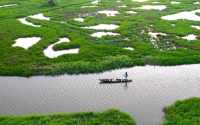Published on Thursday, January 13, 2005 by Knight RidderTim Johnson
An official document posted here says that nearly 210,000 people in Indonesia are dead or missing from the Dec. 26 tsunami, a toll that appears to be far higher than officials have reported publicly. Rescue workers think even that number may be low.
The larger Indonesia toll would bring the total of dead and missing from the tidal surge across the Indian Ocean to nearly 272,000, ranking the tsunami as the fifth or sixth deadliest natural disaster in about 250 years.
The new toll came as Indonesian officials restricted the movements of foreign relief workers, U.N. employees and journalists in devastated north Sumatra, the Indonesian island that took the brunt of the tsunami's force, and said foreign military units would be allowed to work in the country for only a limited time.
Indonesia's vice president told the United States and other nations that have sent troops to deliver relief that their forces won't be permitted to remain in Sumatra longer than three months, and should leave as soon as their work is completed.
The chief of operations for the government's disaster-relief efforts here, Budi Atmadi Adiputro, said in a statement that it was "necessary" for all foreigners in Aceh province, at the northern end of Sumatra, to provide authorities with details of "their current and planned activities as well as the exact locations those activities will be carried out."
The blunt comments seemed to end what had been tacit Indonesian acceptance of a foreign presence in an area that has been off limits to foreigners for years. But it wasn't clear that the comments would have any real impact on rescue efforts.
Few civilian relief workers seemed concerned that the restrictions would hurt their missions, and Indonesian officials promised quick approval for missions outside of Aceh's principal cities.
U.S. aircraft continued to fly relief missions, though helicopters from the aircraft carrier Abraham Lincoln had to refuel elsewhere after the Lincoln moved out of Indonesian waters after the Indonesian government refused permission for U.S. training flights over its territory.
Indonesia, which emerged from three decades of military dictatorship in 1998, remains strongly influenced by the armed forces, some of whose officers are discomfited by the sudden presence of foreigners in a conflict-ridden province that's the source of huge earnings from natural gas exports.
Human rights groups have long complained of the military's crackdown on separatists from the Free Aceh Movement, and the United States ended military exchanges over the issue during the Clinton administration. Tensions over the presence of foreign troops have been obvious for days, with U.S. Marines scaling back planned operations after the Indonesians objected to the Marines' carrying weapons on Indonesian territory.
Indonesian officials offered no explanation for the sharp rise in the number of dead and missing. Earlier this week, a Cabinet-level official put the toll in Aceh province at about 108,000, between those already buried and those known to be dead. Another 48,000 were missing, the official said.
But a chart posted at the entrance to the federal disaster-relief headquarters here offered different numbers.
Compiled by the Disaster Management Task Force for Aceh province, the document listed numbers of casualties by district in a variety of categories, including buried, known dead and missing.
The document gave the number of people known to have died in the disaster at 78,395 and said another 131,479 remained lost or missing. It said the information was current as of 9 p.m. Tuesday (9 a.m. EST Tuesday).
Asked about the document, an American working for the Indonesian government, Laura Worsley-Brown, said it was posted in response to reporters' inquiries about the numbers of dead and missing and was being offered in place of official statements.
Those returning from the field said they weren't surprised by the new numbers. Dr. A. John Watson, the president of CARE Canada, cited the town of Calang, halfway between the provincial capital of Banda Aceh and Meulaboh, which is on the western coast, as "a really hard-hit case. Eight or nine thousand people in that town were wiped out. About 1,000 survived." He said he expected the final death toll to be "significantly higher."
The precise death toll is unlikely ever to be known. Thousands of people were washed to sea, and their bodies probably never will be recovered.
But the new figures rank the tsunami in the same category as a 1976 earthquake in China that killed at least 255,000 people. The worst natural disaster since 1750 is thought to have been a flood in China in 1939 that killed an estimated 3.7 million people.
The travel restrictions announced Wednesday apply to all foreigners, including "individuals, country representatives, United Nations agencies, NGOs (nongovernmental organizations), or media in Aceh province," the government statement said.
The government said it acted out of concern that insurgents of the Free Aceh Movement might undertake violent acts and said military escorts would be provided in certain cases.
But aid workers said authorities might fear that relief groups or journalists would help the insurgents, who've been fighting for independence for the province since 1976.
Alwi Shihab, a Cabinet-level appointee of President Susilo Bambang Yudhoyono, declined to say what would occur to individuals or groups that didn't register.
"We are sure you are civilized persons and will comply with regulations for your own safety," Shihab said.
The announcement said foreigners were free to work in and around the two hardest-hit cities, Banda Aceh and Meulaboh, a city near the epicenter of the massive quake and tsunami. For other locations, foreigners must send a request to a team led by the Aceh regional police chief and await a decision.
"It will not take long," Shihab said. "It will be within hours, not days."
Aceh has been largely off-limits to foreigners since early 2003, when a cease-fire broke down and martial law was declared. Shihab noted that a lower-level emergency rule that permits restricted civil liberties remains in effect.
Reaction among foreign relief officials ranged from concern about security in the countryside to apprehension that the government may be allowing security concerns to trump humanitarian needs.
Most, however, appeared so intent on providing aid to as many as 650,000 displaced people in Aceh that they took the restrictions as simply another hurdle in an already difficult situation.
http://www.commondreams.org/cgi-bin/print.cgi?file=/headlines05/0113-07.htm






